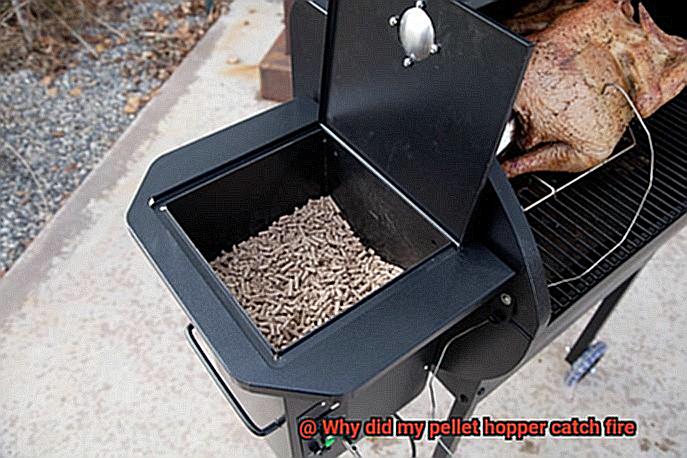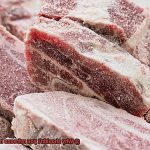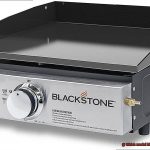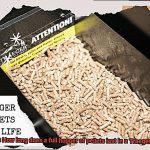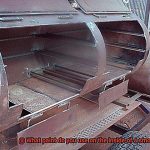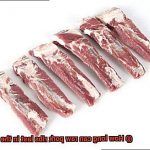Do you love the smoky flavor of pellet-grilled meat? If so, then you know how important it is to keep your grill in top condition. But have you ever had the terrifying experience of watching your pellet hopper catch fire? It’s a nightmare that many pellet grill enthusiasts have faced, and it can cause serious damage to your grill, property, and even your safety.
So why did your pellet hopper ignite? There are several reasons why this might happen: poor maintenance, worn-out components, low-quality pellets, or even user error. When heat builds up in the hopper and reaches a critical point, the pellets can ignite and start a fire. However, with proper care and attention, you can prevent this from happening. Regular cleaning, using high-quality pellets, and monitoring temperature controls are simple steps that can help reduce the risk of fire.
In this blog post, we’ll explore the most common causes of pellet hopper fires and provide practical tips to avoid them. We’ll also share some expert advice on how to keep your pellet grill running smoothly and safely so you can enjoy mouth-watering BBQs without any worries.
So let’s dive into this crucial topic together and learn how to keep our beloved pellet grills in tip-top shape.
Contents
What is a Pellet Hopper?
Pellet grilling has revolutionized the way we cook, making it easier than ever to prepare mouthwatering meals with minimal effort. But as with any cooking method, safety should always be a top priority. This is especially true when it comes to pellet grills, which rely on a crucial component known as a pellet hopper.
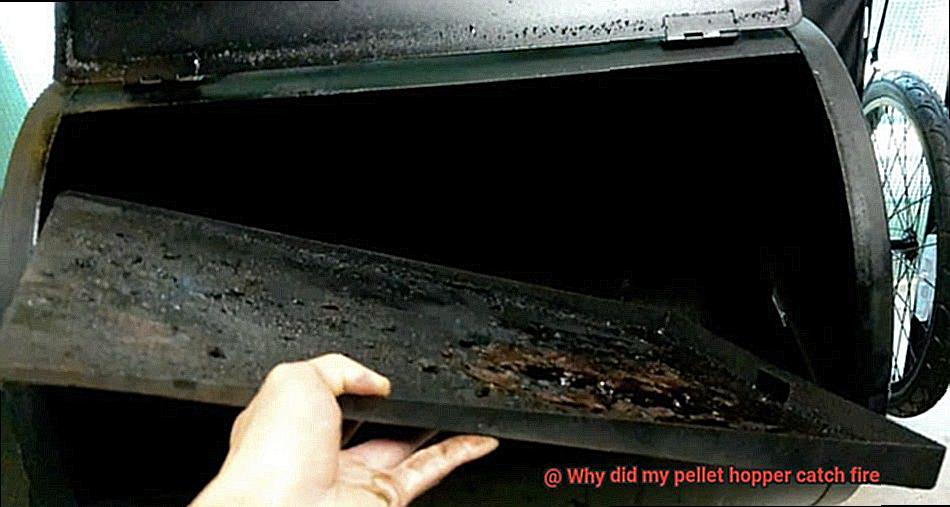
So what exactly is a pellet hopper? Simply put, it’s the container that holds the wood pellets used as fuel in a pellet grill. These pellets are automatically fed into the burn pot by an auger, where they ignite to produce heat and smoke for cooking food. Pellet hoppers come in different sizes, depending on the size of the grill and its intended use. They’re typically made of metal like stainless steel or aluminum, which can withstand high temperatures and resist corrosion.
To ensure smooth and consistent feeding of pellets into the burn pot, pellet hoppers are equipped with various features. These include an auger motor that rotates the auger to move the pellets, a hopper lid that prevents moisture from getting into the pellets and causing them to clump together, and a hopper drain that allows excess pellets to be removed easily.
However, if not maintained properly or if any of its components malfunction, a pellet hopper can pose serious safety risks. One of the most common concerns is the risk of fire. This can occur due to several reasons, such as a buildup of excess pellets, a malfunctioning temperature control system, or using low-quality pellets.
To prevent these issues and reduce the risk of fire, it’s essential to regularly clean and maintain your pellet hopper. This includes checking the temperature control system and investing in high-quality pellets. By taking these precautions, you can enjoy the convenience and deliciousness of pellet grilling without worrying about any potential hazards.
Causes of Pellet Hopper Fires
Pellet grilling is a top-choice cooking method for many who love the ease and flavor it provides. However, safety should always be a top priority, especially when it comes to potential pellet hopper fires. Knowing the causes of these fires can help prevent them from happening and ensure a safe grilling experience.
Creosote buildup in the hopper is one of the primary causes of pellet hopper fires. This flammable substance can accumulate due to poor maintenance or low-quality pellets. Once the hopper temperature exceeds the ignition point of creosote, it can ignite and cause a fire. To prevent this, make sure to clean your hopper regularly and use high-quality pellets.
Electrical malfunction is another culprit that can cause pellet hopper fires. Faulty wiring or damaged electronic components can cause sparks or short circuits, which can ignite the pellets in the hopper. Before using your grill, check that all electrical connections are functioning correctly and replace any damaged components.
Proper ventilation is critical in preventing pellet hopper fires. Without adequate airflow, heat can build up inside the hopper, causing the pellets to combust. Make sure to keep your grill’s vents clear and clean to ensure proper ventilation.
Lastly, leaving your grill unattended while it is still hot can also lead to pellet hopper fires. The residual heat from the grill can ignite the pellets in the hopper, causing a fire. Always let your grill cool down before leaving it unattended.
Buildup of Excess Pellets
Pellet grilling is a true art form that requires skill, patience, and attention to detail. However, to truly master the craft, it’s vital to consider safety precautions to prevent potential pellet hopper infernos. One of the most common causes of pellet hopper fires is the buildup of excess pellets.
Over time, pellets can accumulate in the hopper, particularly if the grill is not used frequently or left unused for an extended period. This buildup can pose a severe problem when the pellets come in contact with the heat source and ignite. To avoid this dangerous scenario, it’s crucial to clean the hopper regularly. By emptying the hopper and vacuuming out any remaining pellets or debris, you can prevent excessive pellet buildup.
Another significant factor that can contribute to excess pellet buildup is using the wrong type of pellets. Pellets that are too long or too wide can cause blockages in the hopper, preventing proper feeding into the firebox. This can lead to uneven burning and an increased risk of fire.
Using high-quality pellets that produce less ash can also help minimize the amount of buildup in the hopper. These types of pellets are known to produce fewer byproducts that could clog your grill’s system and cause damage.
While pellet hopper fires are relatively rare, they pose a severe danger that could lead to extensive damage to your grill and surrounding area. Taking preventative measures such as regular cleaning and using high-quality pellets can help reduce the risk of a fire. Suppose you suspect that your pellet hopper may be experiencing excess buildup or notice anything unusual. In that case, it’s best to consult a professional or contact the manufacturer for guidance.
Malfunctioning Temperature Control System
Pellet grilling is an excellent way to cook mouth-watering meals for your loved ones, but it’s critical to understand the potential risks that come with this cooking method. One of the most significant hazards is a malfunctioning temperature control system, which could lead to a pellet hopper fire.
Pellet grills work by feeding wood pellets into a heating element, which ignites the pellets and generates heat for cooking. The grill’s temperature is regulated by a thermostat that controls the flow of pellets into the heating element.
When the temperature control system malfunctions, it can cause excess pellets to feed into the heating element. This results in too much heat being produced, which could ignite the pellets in the hopper. This danger increases if the hopper is made of combustible materials like plastic or wood.
Several factors could cause a malfunctioning temperature control system, such as damaged wiring or a faulty thermostat. Therefore, it’s vital to inspect and maintain your pellet grill regularly to prevent any potential issues from occurring.
To avoid pellet hopper fires caused by a malfunctioning temperature control system, invest in high-quality equipment from trusted manufacturers known for their safety and reliability. Follow all safety instructions provided by the manufacturer and never leave your grill unattended while in use.
Furthermore, keep your pellet grill away from flammable materials such as grass or wood chips. Place it on a flat surface with nothing above or behind it that could catch fire.
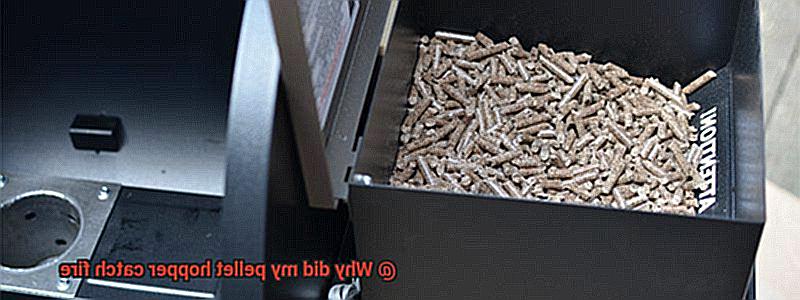
Low-Quality Pellets
Pellet grilling is a fantastic way to cook delicious and flavorful meals for your friends and family. However, there’s a lurking danger that can really ruin your grilling experience – low-quality pellets. These pellets are made from compressed sawdust and wood waste materials, and their quality can vary widely. But did you know that low-quality pellets can be a significant cause of pellet hopper fires? In this article, we’ll explore why low-quality pellets can be dangerous and how you can prevent these fires from happening.
Blockages are one of the main problems with low-quality pellets. These pellets may contain excessive amounts of bark, dirt, or other impurities that can cause blockages in the hopper or auger system. This restricts the flow of pellets through the system and increases pressure and friction, leading to overheating and fire. The auger motor may try to compensate for this by working overtime, which can overheat the motor and cause a fire.
Ash buildup is another issue with low-quality pellets. They produce more ash than higher quality pellets, which can cause clogs and blockages in the hopper or burn pot. As a result, the flow of pellets through the system is restricted, leading to overheating and fire.
Low-quality pellets may also contain excessive moisture, causing them to swell and stick together in the hopper or auger system. This leads to clogs and blockages that increase the risk of fire.
To prevent these dangerous pellet hopper fires caused by low-quality pellets, it’s crucial to purchase high-quality pellets from reputable suppliers. Look for pellets certified by organizations such as the Pellet Fuels Institute (PFI) or ENplus, which establish standards for pellet quality and production. Regular maintenance of your pellet grill or smoker is also essential in preventing hopper fires caused by low-quality pellets. Cleaning out ash and debris regularly and inspecting the hopper and auger system for blockages can help prevent overheating and fires.
Prevention Tips for Avoiding Pellet Hopper Fires
Pellet hopper fires can be a scary and potentially dangerous experience for grillers. However, with proper prevention measures, you can significantly reduce the risk of a fire and enjoy safe and delicious grilling experiences all year round. Here are five sub-sections that expand on the prevention tips for avoiding pellet hopper fires:
Clean your grill regularly
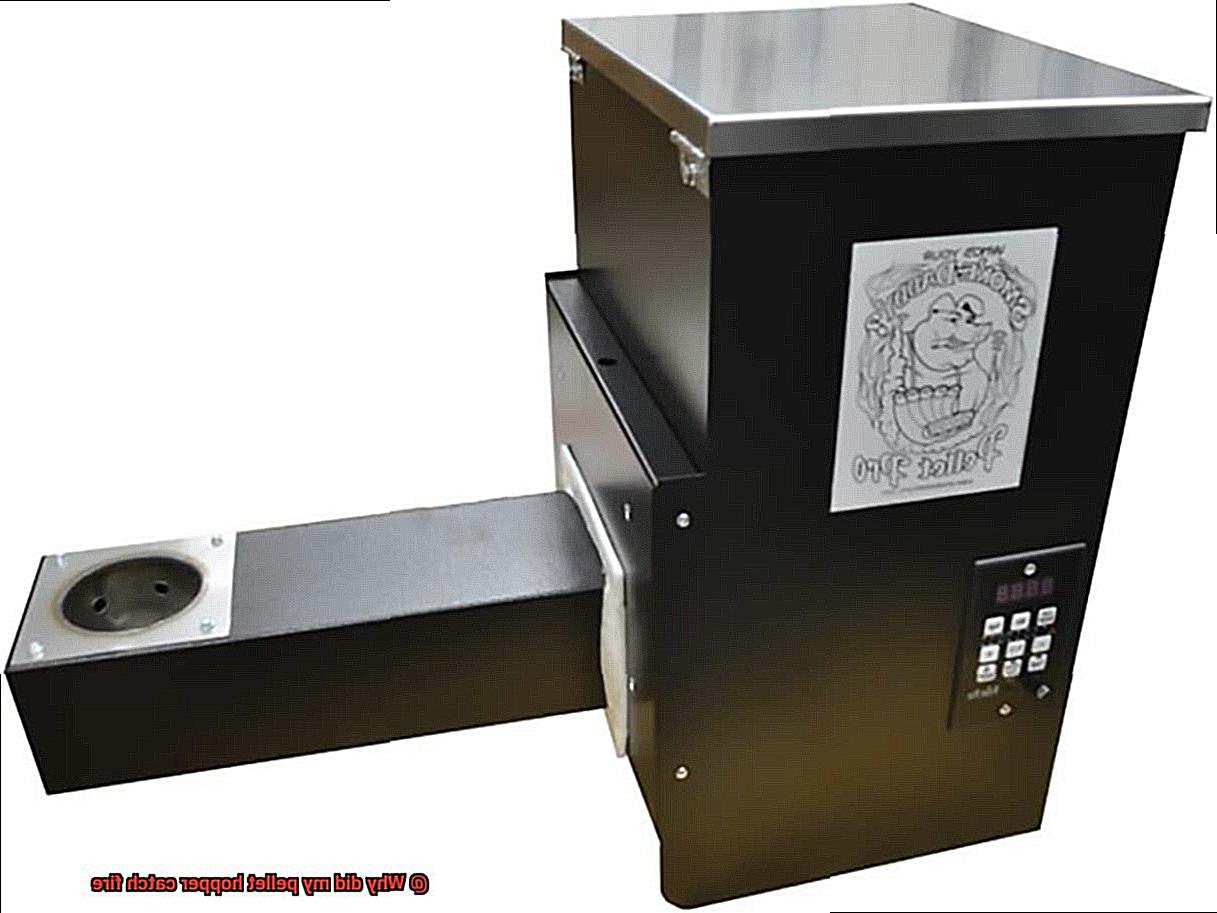
One of the most important prevention tips is to clean your grill regularly. Grease and debris buildup can ignite and cause a fire in the hopper or burn pot. To prevent this, make sure you clean out the hopper, auger, and burn pot after every use. Additionally, it’s best to clean your grill while it’s still warm, as this makes it easier to remove any buildup.
Use high-quality pellets
Not all pellets are created equal, and some can be more prone to causing fires than others. Low-quality pellets can create more ash and debris, which can lead to increased buildup in the hopper and burn pot. High-quality pellets burn cleaner and leave less ash behind, reducing the risk of a fire. Make sure you invest in high-quality pellets that are free from moisture, mold, and other contaminants that can increase the risk of fire.
Monitor the temperature
Pellet grills operate at high temperatures, which can increase the risk of fire if not monitored carefully. It’s important to keep an eye on the temperature gauge and adjust accordingly to prevent overheating. If you notice that the temperature is too high, lower it immediately to avoid a potential fire in the hopper or burn pot.
Use a grill cover
A grill cover can protect your grill from the elements and prevent debris buildup inside the hopper. This is especially important if you store your grill outside or in an area prone to moisture or other elements that can increase the risk of a fire.
Install a thermal blanket
A thermal blanket can help regulate the temperature inside the hopper and prevent overheating. This is particularly useful if you live in a colder climate or plan to use your grill in low temperatures. A thermal blanket can also help reduce fuel consumption and extend the life of your grill.
Clean the Hopper Regularly
If you’re a fan of pellet grills, then you know that they’re an excellent way to cook up mouth-watering meals. However, did you know that cleaning your grill’s hopper is just as crucial as choosing the right pellets or monitoring the temperature?
Pellets are made of wood and can absorb moisture from the air, causing them to clump together and form blockages in the hopper’s auger. This can lead to overheating inside the hopper and increase the risk of a fire. Moreover, dust can accumulate inside the hopper, reducing airflow and further increasing the risk of combustion.
To prevent such incidents, it’s essential to clean the hopper regularly. The following are some easy steps to follow:
- Turn off and unplug your grill.
- Remove any leftover pellets from the hopper using a scoop or vacuum.
- Use a dry cloth to wipe down the inside of the hopper, eliminating any remaining dust or debris.
- Inspect the hopper’s auger for any signs of damage or blockages and clean it as necessary.
By taking this simple step, not only will you keep your grill functioning correctly, but you’ll also reduce the risk of a fire breaking out.
It is recommended to clean your hopper after every 2-3 uses or at least once a month if you use your grill frequently. By doing so, you’ll ensure that your pellet grill functions properly for years to come.
Check the Temperature Control System
Grilling is a beloved pastime for many, but it’s important to prioritize safety when using a pellet grill. One area that requires attention is the temperature control system. This system plays a crucial role in regulating the grill’s heat and preventing potential fire hazards.
The thermostat is a key component of the temperature control system. It monitors the grill’s temperature and adjusts the fuel supply as needed. If it’s not functioning properly, the grill could run too hot and potentially ignite pellets or other materials in the hopper. Therefore, it’s important to regularly test the accuracy of the thermostat to ensure it’s working correctly.
Another component of the temperature control system is the fan that circulates air through the grill. If this fan isn’t working correctly, it can lead to hot spots or uneven heating, which could also increase the risk of fire hazards. Regularly checking for any obstructions in the fan is crucial to maintaining its functionality.
To ensure your pellet grill is functioning safely and efficiently, it’s crucial to regularly inspect your temperature control system. Verify that all electrical connections are secure, and take note of any signs of wear and tear. By taking these proactive measures, you can reduce the risk of potential fire hazards.
It’s also important to never leave your pellet grill unattended while it’s in operation. Even with a properly functioning temperature control system, accidents can happen unexpectedly. Keep a fire extinguisher on hand and always stay nearby while grilling.
Invest in High-Quality Pellets
Investing in high-quality pellets is the secret to a safe and scrumptious grilling experience. As a grilling expert, I cannot stress enough how vital it is to use high-quality pellets. These pellets reduce the risk of fire, produce less ash, and make your food taste heavenly. Here’s why:
Low-quality pellets are often made from scrap wood or contain fillers and additives that cause hot spots and uneven heating in your grill. This can lead to a buildup of unburned pellets in the hopper, which can ignite and cause a fire. Furthermore, low-quality pellets may contain chemicals or impurities that can release harmful fumes when burned, posing a risk to your health.
In contrast, high-quality pellets are made from dense hardwoods like oak or hickory and are free from additives and fillers. The density of these pellets means that they burn more efficiently, produce less ash, and maintain a consistent temperature for an even cook. By investing in high-quality pellets, you’re investing in the longevity of your grill.
Moreover, investing in high-quality pellets means that you enhance the natural flavors of your food and achieve that smoky, delicious taste that we all love. It’s like adding magic to your grill.
When shopping for pellets, look for brands certified by reputable organizations such as the Pellet Fuels Institute (PFI). These certifications ensure that the pellets meet certain quality standards and are safe to use.
naEqk_GdmGU” >
Conclusion
In conclusion, the key to a safe and enjoyable grilling experience is maintaining your pellet grill in top condition. Pellet hopper fires can be terrifying and dangerous, but with proper care and attention, they can be prevented. Regular cleaning, using high-quality pellets, monitoring temperature controls, and investing in high-quality equipment are all essential steps to minimize the risk of fire.
To prevent pellet hopper fires from happening, it’s important to understand their causes. Creosote buildup, electrical malfunctions, improper ventilation, and leaving the grill unattended while hot are all common culprits that can lead to fire hazards.
Don’t overlook the importance of cleaning the hopper regularly and checking the temperature control system as prevention measures. Investing in high-quality pellets not only enhances your food’s natural flavors but also reduces the risk of fire hazards.
By following these tips and taking proactive measures to maintain your pellet grill’s safety and functionality, you can enjoy mouth-watering BBQs worry-free.

